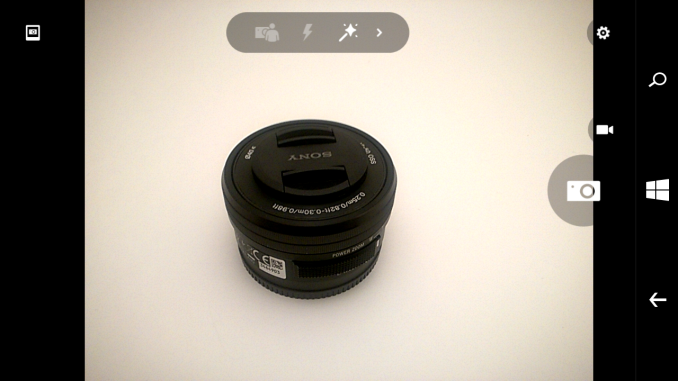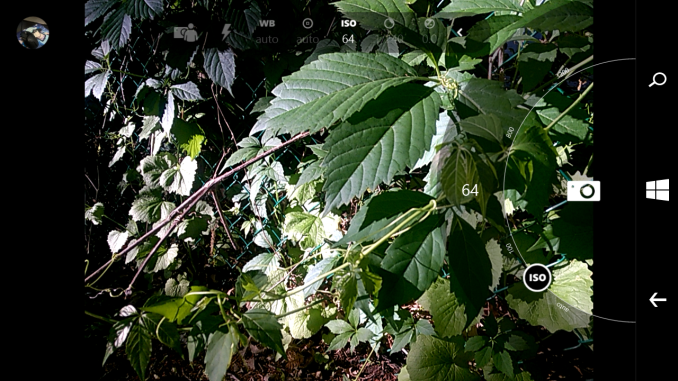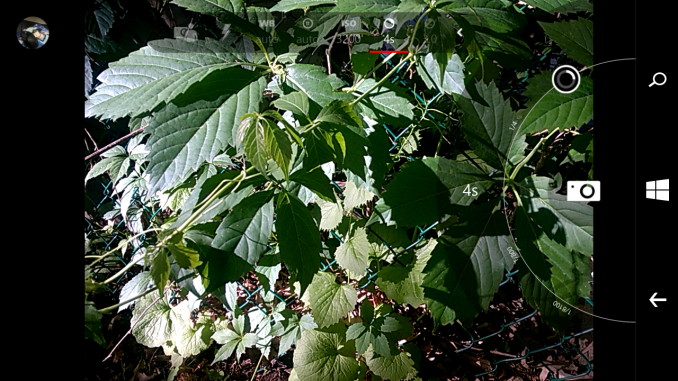The Microsoft Lumia 640 Review
by Brandon Chester on June 9, 2015 8:00 AM EST- Posted in
- Smartphones
- Microsoft
- Mobile
- Lumia
- windows phone 8
Camera Architecture
Due to the more closed nature of Windows Phone, I can’t do much poking around to find detailed information on the cameras in the Lumia 640. The information that I have been able to collect is organized in the chart below. The main omission is the sensor manufacturer, which I would suspect is Omnivison or Toshiba, but I can’t say for sure exactly what it is.
| Microsoft Lumia 640 Cameras | ||||
| Front Camera - Resolution | 0.9MP (1280x720) | |||
| Front Camera - Focal Length | 1.5mm (30mm eff) | |||
| Front Camera - Aperture | F/2.4 | |||
| Rear Camera - Resolution | 8MP (3264x2448) | |||
| Rear Camera - Sensor Size | 1/4", 1.12µm pixels | |||
| Rear Camera - Focal Length | 3.0mm (28mm eff) | |||
| Rear Camera - Aperture | F/2.0 | |||
On paper, the Lumia 640’s camera hardware is better than a lot of other devices at this price point. I recently reviewed the 2015 Moto E, and on paper the Lumia 640 has higher resolution cameras with larger sensors on the front and back, and the front camera has a significantly wider aperture. While the specifications of the camera sensor and lens aperture hardly tell the whole story when it comes to image quality, they definitely put the Lumia 640 in a better position when it comes to sharpness and low light performance.


The focus time on the Lumia 640 sits right in the middle of our comparison results. It’s slightly faster than many other devices that don’t have PDAF or laser based autofocus, but it’s not as fast as phones like the Nexus 6, and not near as fast as the iPhone 6 and Galaxy S6 with their PDAF. Shot latency is also right around the middle, and while there is a tiny bit of a delay between shots, I never felt like I was kept waiting for an unreasonable time when trying to take several photos quickly.
Camera UX
A device’s camera application has a big impact on the user’s experience when taking photos or shooting video. If the camera preview is cropped or badly scaled then it’s difficult for the user to gauge what their photos will look like. A high resolution preview and an accurate aspect ratio are necessary to frame and compose photos properly. For quite some time I’ve heard great praise for the Lumia camera application interface and the manual controls that it offers, so I was excited to have a chance to try it in depth.
Upon first opening the Lumia Camera app, I felt like the interface was fairly organized and well laid out. It was immediately obvious that tapping the right-facing arrow in the menu at the top would reveal more controls, and that hitting the gear in the upper right would show me options. Having a button to instantly record video is also very handy. The camera preview would definitely be improved if it were higher resolution, but this is mostly a limitation of the ISP so there's not much that can be done.
Once I started trying to use the manual controls I was very happy that the app uses what is basically a dial interface to make adjustments. It reminds me a lot of the control dials on a real camera, which is a good design decision, as anyone interested in these controls probably has prior experience with photography.
Unfortunately, I very quickly ran into a number of issues with the manual controls on the Lumia 640. The first problem was that I seemingly could only adjust one option at a time. While this is a common limitation of smartphone camera interfaces, it was very annoying because you had to continually move your thumb between the control wheel and the menu at the top. This is a much less ergonomic and more time consuming method of adjustment than something like ASUS’s camera interface where the menu for selecting each control and the menu for performing adjustments are beside each other.
After asking people who were more familiar with Windows Phone, I was told that you can pull outwards on the shutter button to bring up every control at once. I have two issues with this gesture. The first is that it’s not obvious at all. The only way I was able to find it was because I was told by another person, and that alone is a pretty massive design failure. My other issue is that it doesn’t directly solve my problem. I want the settings and the menu for adjusting them to be adjacent, not a giant menu of controls covering up the camera preview.
The fact that you wouldn’t be able to see the changes you’re making reflected in the preview because it’s covered by semi-opaque menus would be a big issue if it weren’t for an even bigger problem with the Lumia Camera application. The biggest issue of all is that camera preview does not change to reflect adjustments to ISO and shutter speed. At first, I had assumed my device was suffering from a bug, but after doing some troubleshooting I asked our editor Brett Howse to confirm that his Windows Phones behaved the same way. When he confirmed that they did I really didn’t know what to say. Having manual camera controls that aren’t reflected in the camera preview makes them essentially unusable. While changes to white balance, brightness, and focus do show up in the preview, your adjustments to ISO and shutter speed do not. This means that you have no visual idea of what the exposure of your photo is going to be.
I wasn’t near as impressed with the Lumia Camera application as I had expected to be based on what I had heard about how camera-centric Lumia devices are. While the interface for auto mode is fine, it’s basically impossible to mess that up unless you're trying to. The manual controls aren’t implemented in a very obvious and accessible manner, and the most important ones require you to just pray that the exposure meter is accurate, which ruins the entire concept of having full control over how your photos turn out.














130 Comments
View All Comments
eanazag - Tuesday, June 9, 2015 - link
I hated Symbian. Buh-bye Symbian.Callum S - Tuesday, June 9, 2015 - link
Nice review. I definitely think that it is a fantastic phone for its price.I can see how the apps situation for some would be a pretty big concern. As mentioned it is mainly Google and local apps that are missed. However at the same time, for those using Microsoft services, I have found it to be significantly better than Android. Exchange, OneDrive, OneNote and MS Office Apps all work beautifully and the ability to pin the live tiles for each to the home screen has saved myself tonnes of time.
That blue glossy case - yep, I would probably want to pass on that too. The matte black version is however also available and in my opinion much better.
I am not too sure about the performance though - especially at the price bracket. After breaking a Nokia 930 I tried to use an old HTC One M7 for a while, before finally buying a Lumia 640, and found the performance of that to be horrible after updating. However perhaps that was due to the HTC sense customisations or something?
My original intention was to use the Lumia 640 until the Lumia 940 with Windows Mobile 10 is released however I am not too sure I'll be able to justify the upgrade now...
Callum S - Tuesday, June 9, 2015 - link
*HTC Sense customisationsWolfpup - Tuesday, June 9, 2015 - link
The HTC stuff may not help, but from my experience Android is just dog slow. I've got a Surface 1 running (almost) real Windows 8, and it runs circles around faster ARM hardware running Android, which is just laughable considering how much better Windows is than Android.Presumably Windows Phone has even lighter system requirements, so... Although who knows about that, given real Windows is probably optimized out the wazoo, while Windows Phone doesn't get as much attention, but still, my Windows Phones all feel fine, while my android stuff running on anything less than the highest end hardware feels slow.
testbug00 - Tuesday, June 9, 2015 - link
Android runs fine when you don't skin it. Moto G/E use A7 quad cores. I believe the original Moto E used a dual core even.And, based on crash reports I've seen, Windows Phone seems to use under 125MB of RAM for the OS.
Daniel Egger - Tuesday, June 9, 2015 - link
Nope, Moto E (2nd gen) runs 4xA53 not A7. Also not to be underestimated the Moto E has a lower screen resolution.mkozakewich - Tuesday, June 9, 2015 - link
In my experience, a proper operating system like Windows or OS X runs a lot faster than some generic, unoptimised version of Linux. I had a netbook with a quick-boot Linux thing, and I could actually turn off my backlight completely when I used it, but my battery would actually drain quicker than when I'd have the screen on in Windows.leexgx - Thursday, June 11, 2015 - link
unlike Android it's a requirement that all apps use GPU acceleration under normal use on windows even on old/new crappy 512mb windows phones run Very consistently (more like IOS iPhone/iPad) with Android your having to use Brute force with faster Flash and CPU (android is only been optimised now in 5.0)testbug00 - Tuesday, June 9, 2015 - link
probably HTC stuff. I have a Moto G (whatever year the original was released in) and it runs Android smoothly. It's a lot weaker than the M7 ;)WorldWithoutMadness - Tuesday, June 9, 2015 - link
Cmon microsoft, just give us sneak preview of 940 already. I'm sick of this badly chosen hardware budget phone.It's not even good enough in super saturated budget phone market in developing country.